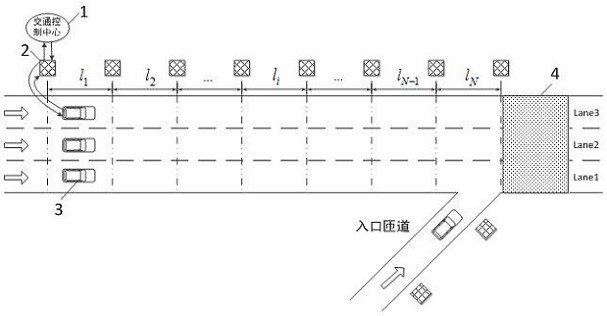Highway variable speed limit and lane change cooperative control method under vehicle-road cooperation
A technology of expressway, vehicle-road coordination, applied in the direction of controlling traffic signals, etc., can solve the problems of traffic flow, uncontrollable, vehicles unable to change lanes smoothly, etc., to reduce the capacity drop, improve traffic conditions, and improve traffic efficiency.
- Summary
- Abstract
- Description
- Claims
- Application Information
AI Technical Summary
Problems solved by technology
Method used
Image
Examples
Embodiment 1
[0069] A coordinated control method for expressway variable speed limit and lane change under vehicle-road coordination, such as figure 1 As shown, follow the steps below:
[0070] S1: Lay out roadside unit 2. Roadside unit 2 is arranged longitudinally along the roadside. The distance between two adjacent roadside units is 50m. Divide the highway section containing the entrance ramp into several control sections, and the main lane downstream of the entrance ramp is Bottleneck area 4; roadside unit 2 receives the information of all vehicles passing through all control sections of the current main line and on-ramps (that is, communication vehicles 3 ), and sends them to the traffic control center 1 .
[0071] S11: If figure 2 As shown, the control road section has two division dimensions, that is, the division along the direction of traffic flow and the division along the width direction of the highway; l The sections of the traffic flow are numbered sequentially from the up...
Embodiment 2
[0129] like figure 2 As shown, there is an expressway section with an entrance ramp, and its main line is two-way six-lane (one-way three-lane). The expressway section with an entrance ramp is divided into 10 identical sections with a length of 1 km, numbered 1 to 10, Right now N Equal to 10; each road segment is divided by lane, numbered 1 to 3 from the outer lane to the inner lane, that is J Equal to 3; one roadside unit is laid every 50m;
[0130] Assuming that the maximum capacity of each lane is 1800veh / h based on historical data, the maximum speed limits of lanes 1, 2, and 3 are 80, 100, and 120km / h respectively, and the critical densities are 23, 18, and 15veh / km / ln (vehicle / km / lane), namely =23 veh / km / ln, =18 veh / km / ln, =15veh / km / ln; Section 1 ( i =1) the critical density of the first lane and the road section N ( i = N ) is the same as the critical density of the first lane.
[0131] Critical density for on-ramps It is 18veh / km / ln, and the maximum sp...
PUM
 Login to View More
Login to View More Abstract
Description
Claims
Application Information
 Login to View More
Login to View More - R&D
- Intellectual Property
- Life Sciences
- Materials
- Tech Scout
- Unparalleled Data Quality
- Higher Quality Content
- 60% Fewer Hallucinations
Browse by: Latest US Patents, China's latest patents, Technical Efficacy Thesaurus, Application Domain, Technology Topic, Popular Technical Reports.
© 2025 PatSnap. All rights reserved.Legal|Privacy policy|Modern Slavery Act Transparency Statement|Sitemap|About US| Contact US: help@patsnap.com



